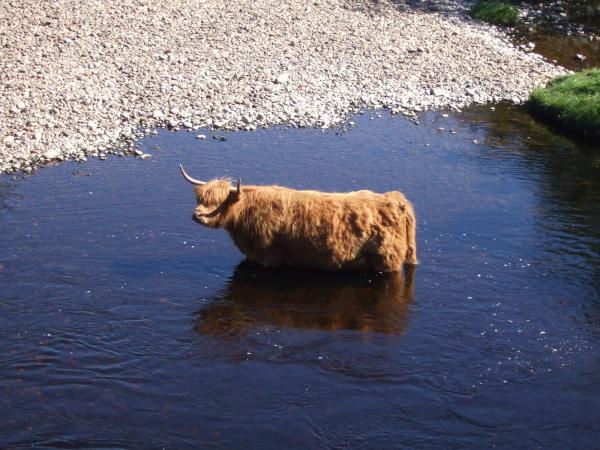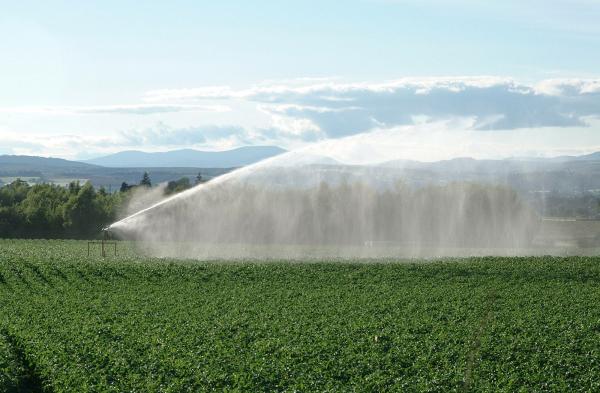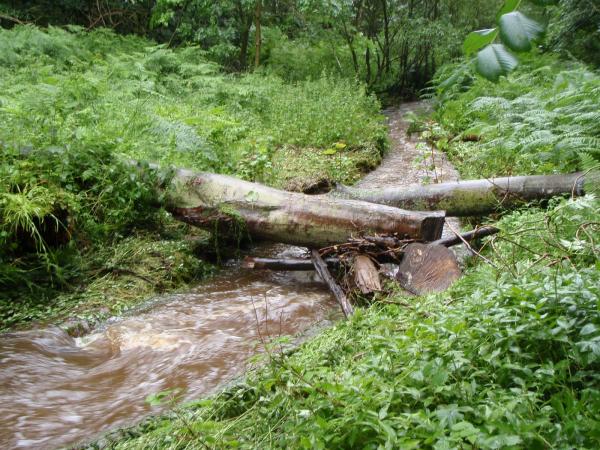Does Scotland have a water scarcity problem – and what can we do about it?
We may think of Scotland as a wet country, where summer holidays are more often than not ruined by a downpour and water is abundant. Yet, concerns about water scarcity are increasingly in the headlines.
Low river water levels in mid-August last year (2022), caused the Scottish Environment Protection Agency (SEPA) to issue a water abstraction bans in several river catchments. This temporary ban prevented water use for things like farmland irrigation.
This year, SEPA’s water scarcity warnings have covered greater areas. Nearly all of Scotland was under at least an “early” warning by the end of June. Large areas were also under “moderate scarcity”, including the Nairn, Findhorn, Dee and Spey catchments, while the Loch Maree area, the Rivers Annan, Nith, the Black Isle and the Outer Hebrides were under “significant scarcity”.
While these alerts eased, following increased rainfall in July, it’s a problem that’s not going away.

- Is climate change driving increasing water scarcity in Scotland and how?
Dr Mike Rivington, a senior scientist at the Hutton, who has researched land use and climate change for more than 23 years, says, “We are seeing and are going to see more water scarcity events in the future. This is due to climate change. Our research shows summer will become drier, particularly August and September, due to lower rainfall, and higher temperatures, causing more evaporation and reducing water availability.
“We’re already seeing increasing consecutive dry days in summer, especially around September and we’ve already seen temperatures rising to above historic levels, reaching 19.4°C in the month of March over the three decades 1990-2019, compared with 16.9°C in the same month over the previous three decades (1960-1990).
- Expect heavier rainfall in winter
“Conversely, climate change is likely to mean more rainfall in the winter, risking increased flooding,” he says. “The question then becomes how do we store excess winter water for the summer when there is likely to be an increasing deficit? Solutions include greater investment in ecosystem restoration, particularly peatlands, wetlands and woodlands that help store water, and are also beneficial for biodiversity.
“Climate change has also meant there’s less snow cover in winter, reducing how much water is kept for longer on the hills, from where it drains down into our rivers.”
Compared to the past when deep, icy snow accumulated in the Scottish mountains and gradually melted sustaining cool baseflows in rivers well into the summer months, evidence from research conducted at the James Hutton Institute has shown that in recent decades snowfall and accumulation has become more transient, with often extensive coverages of low-density snow, which melt earlier in the spring and deliver less meltwater resulting in warming rivers.

- Does this mean some areas will see more water scarcity than others?
“Where water scarcity events happen will vary according to where you are in Scotland and they will be at different times of the year,” says Dr Rivington. “But it is likely that everywhere will experience periods of greater water scarcity, with the east, southeast and potentially central areas likely to be more affected, with summer and autumn the most impacted period.
A review of the risks to water resources in Scotland in response to climate change
“That doesn’t mean the west coast is immune from water scarcity problems, as we saw in the Loch Maree area this June. It’s fairly usual for the west coast to have quite a warm, dry period in around May-June and sometimes through the summer as well. But the west is more likely to have built up reserves of water during winter.
“This variability in where we’ll experience water scarcity will make managing reservoirs and how much water can be taken from them and rivers, for use on fields, for example, more challenging,” adds Dr Rivington.

- Who does water scarcity impact?
Catchment scientist and systems modeller Dr Miriam Glendell says, “Farmers will face increasing challenges. Some farm businesses rely on from rivers, lakes or lochs and others from ground water. We saw SEPA restrict water abstractions for the first time last summer, which was a challenge for many farmers, so it’s already impacting them. But we’re also seeing some acting and building reservoirs and water holding ponds on their land to store water where they can in order to prepare for these events.”
- Are general users of water impacted, such as homeowners?
Research by the Centre of Expertise for Waters (CREW), based at the Hutton, has also highlighted the vulnerability of users of private water supplies to drought. About 3% of the rural population in Scotland have private water supplies. The highest density of those users are in north-east Scotland, which is expected to experience the largest increase in water shortages.
Dr Glendell says, “According to our research, local authorities across Scotland are already finding that there are more people requesting interventions to help when their supplies run out, for example getting bottled water supply.”

- Are there other types of land that water scarcity could impact?
“Other types of land that are impacted include peatlands, which build up carbon as layers of peat when they are healthy but lose the carbon stores when they are drained in various ways. Increasing drought frequencies can also tip the balance from net carbon accumulation to loss in drought years, even in otherwise healthy peatlands,” says Dr Rebekka Artz, a senior researcher into peatland ecosystems.
“Work is underway through various large projects to restore damaged peatlands, some of which financed via public funding, for example Peatland ACTION. Successful restoration does require that sufficient rainfall is available, which could be a challenge in areas experiencing drought. Our current research programme is aiming to shed a better light on areas where water levels and soil moisture conditions in peatlands are beginning to show the impacts of climate change and so where restoration or other interventions might need to be targeted.”
- Does it also make wildfire a greater risk?
“Wildfire risk is also another potential issue linked to water scarcity, especially when there are longer periods of dry weather, resulting in a buildup of vegetation that that acts like kindling and includes dry peat,” adds Dr Rivington. “But there’s also a human element to this; many wildfires are started by people, perhaps having a barbecue, for example, in the warm weather. We could do more to improve awareness and manage risk through managed burning, to create fire breaks.”

- Does drought impact our wildlife?
“The combined effects of lower water levels, that we’re also seeing in rivers, and rising temperatures, can be catastrophic to river life,” says Dr Susan Cooksley, a catchment scientist and practitioner at the Hutton.
A study by the Hutton looking at the River Spey found that river temperatures had already increased over the last century by 2-3°C, with a high of 27.5°C seen in June 2018 (when the study ended).
“As there is less water, pollutants are concentrated, and all river life is put under immense stress. In really low flow conditions, salmon and sea trout can struggle to migrate upstream and there is greater potential for the spread of disease as fish have to gather in the remaining water.
“For some species, like already critically endangered freshwater pearl mussels, there’s no escape,” she adds. “They can’t react or evolve fast enough to survive. Further compounding the challenges is the lack of snow cover in the mountains, as snowmelt used to provide a flow of cool water into the rivers right through to June, and supported the Spring fish migration upstream.”
For reservoirs and lochs, the problem can also be acute, as the increasing temperature changes the way nutrients are processed, creating toxic environments.
Assessing climate change impacts on the water quality of Scottish standing waters
- What is being done to ease the problem?
“There is work being done to restore rivers,” says Dr Rachel Helliwell, a senior research scientist and Director of CREW. “Rivers that are restored to more natural conditions, with meanders, deep shaded pools and well oxygenated ripples provide the most resilient habitats for river life,” she says. “Deep pools in particular offer refuges and an essential habitat for aquatic life. Riverbank woodlands can also help cool the water and also help reduce pollution running off from agricultural fields as well as provide important habitats, enhancing biodiversity.”
While there is a lot of work ongoing to restore river catchments, it needs to expand at scale, says Dr Cooksley. “We need more riverbank woodland creation to provide vital shade and restoration of wetlands to store of water in times of drought,” she says. “It’s essential that we push ahead urgently with these efforts to build resilience in the face of the changing climate.”
Dr Mark Wilkinson, a senior research scientist, is looking at use of nature-based solutions to hold more water in catchments. This could be by installing “leaky barriers” using felled trees in the water in areas where there isn’t existing woodland, to hold back water in the landscape. This is a way to use nature to help manage climate extremes – such as drought and flooding. Trials of this type of technique are being done in a burn at the Hutton’s research farm at Glensaugh in combination with peatland restoration.
Previous trials using “soft engineering” – creating small wooden barriers – in the landscape to hold water in the land, have also been run working with Glenlivet distillery. “Introducing beavers to suitable areas will have long-term benefits for water storage, but is not as predictable and they need sufficient suitable habitat to be available,” says Dr Cooksley. “As river restoration projects mature, and beaver populations spread, they will play a strong role in helping to create vital pockets of water storage.”
“Other measures could be reducing nutrient inputs on farmland,” adds Dr Glendell. “In some of our work, we’re building a catchment scale computer model, looking at rivers and all the streams and burns that flow into them, which will let us look at what happens when we make changes and so then use water more wisely. We are also modelling the impacts on groundwater resources and nitrate pollution in Scotland under future climate change scenarios.”
“Our soils have great potential to serve as both a water and carbon store,” adds Dr Rivington. “By increasing the amount of organic matter, such as roots, leaves and stems, soils can better retain water and increase carbon storage. This helps improve overall soil biodiversity and therefore soil health. Changes in farm management practices, such as regenerative agriculture (which includes reducing tilling of the land) have the potential to increase soil organic matter whilst maintaining profitable businesses.”
- What about solutions for how we use water?
One challenge is that use of water from our rivers, usually referred to as abstractions, by those with a need for large amounts of water, is likely to exacerbate the impacts caused by droughts, says Dr Shaini Naha, a hydrological modeler at the Hutton.
“But because of a lack of data on how much water is actually being taken out of rivers, the ability to assess the current state of Scotland’s water resources and their vulnerability to climate extremes is limited,” she says.
However, Dr Naha is leading a project to address this problem. Through a project funded by the Hydronation Chair Crucible, in collaboration with the University of Aberdeen, SEPA, and Scottish Water, she is working to create a database which includes how much water is abstracted on a daily basis from river channels.
“Using this information, we can now look at what would happen in different abstraction scenarios, for example if there was a blanket order for ‘no abstraction’ across the country, or if there were restrictions on specific sectors, such as farming. Alongside other models and daily river flow projections, we can then calculate how much water, per river catchment, could be available per day, helping us to better plan and manage drought events.
“This would provide a more realistic assessment of future drought impacts in Scotland and could be particularly helpful in identifying regions and water use sectors that could face increased pressure from water scarcity in the near future.”
- Can we help people who need this water better plan for bans?
The Hutton and colleagues from Biomathematics and Statistics Scotland (BiOSS), which is hosted by the Hutton, are working with SEPA on reviewing the current rules used for assessing drought risk across eighty catchments in Scotland and developing new forecasting models to help SEPA better inform people such as farmers about how long abstraction restrictions might last.
“SEPA also have national water scarcity plans and a risk assessment tool, which we are helping to inform, so that, again, groups who use the water can have a better understanding of what thresholds are being used and how representative it is,” says Dr Glendell.
“More broadly, we all have a part to play, from industry down to individuals. We all need to think and act on how we use water,” adds Dr Glendell. “Ultimately, it’s also about reducing our individual and collective carbon footprint that causes the climate impacts driving these changes that we’re now trying to adapt to.”








Comments
Post new comment